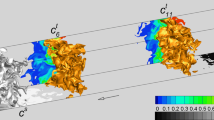Abstract
The equation for the correlation function of a scalar field is used to determine the evolution of a spherical volume of a passive reactive impurity; here, this equation is closed by the proposed relation between the third and second two-point moments. The equation in question is the Corrsin equation with additional terms that determine chemical transformations and the influence of the inhomogeneity of the scalar’s distribution. Concurrently, the equation for the probability density of the concentration of a passive impurity is solved in order to determine the mean rate of chemical reactions. A special feature of this approach is separating the influence of the turbulent field of the velocity and the molecular transfer on the process of mixing. By the compatible solution of these equations, the distribution of the turbulent diffusion and scalar dissipation coefficients and regularities of the reactionwave velocity can be found.
Similar content being viewed by others
References
V. A. Frost, “The model of turbulent diffusion flame,” Izv. AN SSSR, Energet. Transp., No. 6, 108–116 (1973).
N. I. Akatnov and E. N. Bystrova, “Calculations of some characteristics of homogeneous turbulence based on the Karman–Howarth equation closed by a semiempirical model,” High Temp. 37, 865 (1999).
V. P. Krasitskii and V. A. Frost, “Molecular transfer in turbulent flows,” Fluid Dynam. 42, 190–200 (2007).
J. O. Hinze, Turbulence. An Introduction to the Mechanism and Theory (McGraw-Hill, New York, 1959).
V. A. Frost, “Equation for correlation function of scalar and calculation of Schmidt and Sherwood turbulent numbers,” Preprint IPM RAN No. 856 (Inst. Problem Mekhaniki, Moscow, 2008).
R. W. Stewart and A. A. Townsend, “Similarity and self-preservation in isotropic turbulence,” Phil. Trans. R. Soc., Ser. A 243 (867), 359–386 (1951).
V. A. Babenko and V. A. Frost, “Approximation of the third two-point moments of the velocity fields in isotropic turbulence,” Fluid Dynam. 47, 735–747 (2012).
A. N. Kolmogorov, I. G. Petrovskii, and N. S. Piskunov, “A study of the diffusion equation with increase in the amount of substance, and its application to a biological problem,” Byull. Mosc. Univ., Ser. Mat. Mekh. 1, 1–26 (1937).
V. A. Babenko and V. A. Frost, “Conservative differential scheme for Karman–Howarth and Corrsin equation,” Preprint IPM No. 909 (Inst. Problem Mekhaniki, Moscow, 2009).
Author information
Authors and Affiliations
Corresponding author
Additional information
Original Russian Text © V.A. Frost, 2015, published in Matematicheskoe Modelirovanie, 2015, Vol. 27, No. 2, pp. 63–73.
Rights and permissions
About this article
Cite this article
Frost, V.A. Reaction zone in a turbulent fluid. Math Models Comput Simul 7, 430–438 (2015). https://doi.org/10.1134/S207004821505004X
Received:
Published:
Issue Date:
DOI: https://doi.org/10.1134/S207004821505004X



